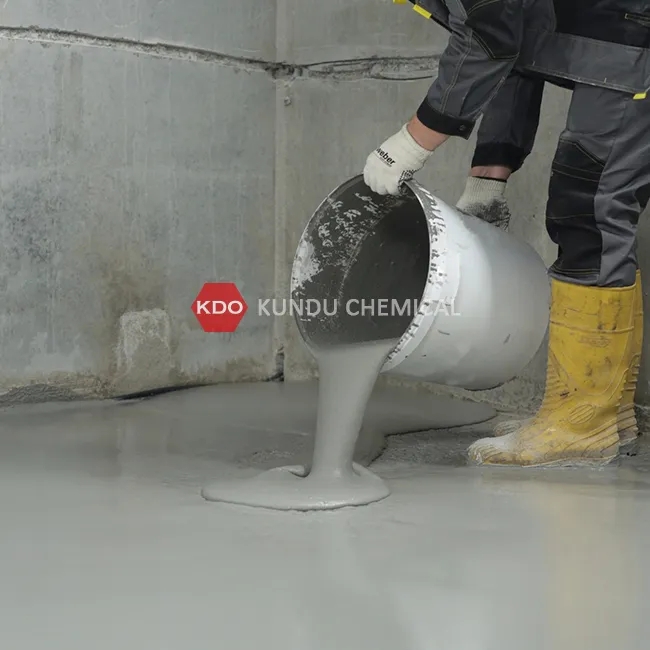- Time:2024/6/6Posted:SHANDONG KUNDU CHEMICAL CO.,LTD.
A typical use for superplasticizers is in self-leveling mortars. Superplasticizers commonly used in self-leveling mortars mainly include casein and melamine formaldehyde condensate, which are essential to ensure that self-leveling mortar has good workability under a certain water-cement ratio. Casein has a very good effect in thin-layer self-leveling mortar, which can make it have good water retention and cohesion, thereby reducing the tendency of segregation and bleeding of self-leveling mortar. However, casein is a natural protein product extracted from milk. When used in cement mortar, it will be chemically degraded by the initial high alkaline condition of the mortar (pH³12) or by the action of microorganisms growing in the mortar. That is, casein can Produces substances containing -NH2 and/or -SH groups, which have an offensive odor. Melamine-formaldehyde condensates often cause formaldehyde emission problems due to the presence of residual formaldehyde. Typical emissions from synthetic superplasticizers with higher formaldehyde content are 1000-2000 µg/m3 after 1 day. At room temperature, these chemicals evaporate enough to cause symptoms such as respiratory and eye irritation. Therefore, the use of casein and some synthetic superplasticizers has been restricted or even banned in some countries. In addition, since casein is a natural product, fluctuations in price and quality are also problems during its use.

To achieve the best performance characteristics of natural and synthetic superplasticizers and consider reducing VOC emissions to a minimum, some companies have developed a series of dispersible polymer powder products with additional fluidization functions to prepare self-leveling mortars without the superplasticizer.
Other types of high-efficiency water-reducing agents such as naphthalene-based and amine-sulfonate water-reducing agents are also used in dry mortar products such as floor hardeners and grouting materials.
Currently, the most widely used types of water-reducing agents are melamine high-efficiency water-reducing agents and polycarboxylate-based high-efficiency water-reducing agents. Their respective characteristics are as follows:
1. Melamine-based high-efficiency water-reducing agent
Melamine-based high-efficiency water-reducing agent, the chemical name is Sulfonated Melamine Superplasticizer, its performance is similar to naphthalene-based water-reducing agent, both are non-air-entraining type, and have no retarding effect. The enhancement effect is slightly better than that of naphthalene-based water-reducing agent, but the dosage and price are also slightly higher than that of naphthalene-based water-reducing agent. After spray drying, melamine-based high-efficiency water reducing agent has been widely used in grouting materials, self-leveling mortars and other products.
The appropriate dosage is generally 0.5% to 2.0% of the cement mass.
2. Polycarboxylate-based high-efficiency water-reducing agent
Polycarboxylate series high-efficiency water-reducing agent is a new type of high-performance concrete water-reducing agent developed and developed with the development and application of high-performance concrete. It has high strength, heat resistance, durability, and weather resistance, etc. Excellent performance. Its advantages are small dosage, high water reduction rate, and good fluidity; good slump retention, and basically no loss of slump within 90 minutes; no formaldehyde is used in the synthesis, and it does not cause pollution to the environment. The use of polycarboxylate-based high-efficiency water-reducing admixtures in dry-mixed mortars is still in its infancy.
The appropriate dosage is generally 0.05% to 1.0% of the cement mass.
Tips while adding water reducing agent to mortar
Ready-mixed mortar is usually mixed with a certain amount of water-retaining and thickening materials, and water-retaining and thickening materials usually have strong water requirements, which increases the unit water consumption of the mortar and also affects the mechanical properties and durability of the mortar. Therefore, appropriate water reducing agents need to be used to disperse the cement slurry system. There are many types of water-reducing agents. Theoretically, melamine-based, sulfamate-based and polycarboxylate-based water-reducing agents can be used as cement slurries. The dispersant of the system is used, but these water-reducing agents not only have greatly different dispersion, plasticizing and reinforcing effects, but also have certain adaptability with the cement, fly ash, slag powder, etc. used. More importantly, ready-mixed mortar is a mixture of multiple components with widely different proportions, especially the presence of thickeners, water-retaining agents and stabilizers, which greatly affects the plasticizing and dispersing effect of the water-reducing agent. . When a certain component of thickener or water-retaining agent exists in the aqueous solution phase, certain types of water-reducing admixtures not only fail to exert their desired plasticizing effect, but sometimes even make the mortar fluidity worse. Therefore, when producing high-fluidity mortar and selecting a water-reducing agent, it is necessary to undergo a large number of experimental verifications to select the most suitable type of water-reducing agent and determine its optimal dosage.





